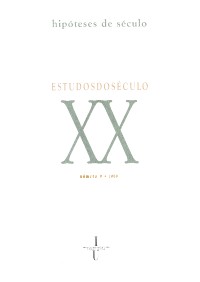Please use this identifier to cite or link to this item:
https://hdl.handle.net/10316.2/36540| Title: | Boémia nocturna e sociabilidade artística: cabarés em Lisboa nos «loucos anos vinte» | Other Titles: | Bohemia night and artistic sociability: cabarets in Lisbon during the «roaring twenties» Boheme nocturne e sociabilite artistique: cabares de Lisbonne pendant les «annees folles» |
Authors: | Vaz, Cecília | Keywords: | Cabaret;Bohemia;Lisbon;Sociability;Modernism;Cabaret;Bohème;Lisbonne;Sociabilité;Modernisme;Cabaré;Boémia;Lisboa;Sociabilidade;Modernismo | Issue Date: | 2009 | Publisher: | Imprensa da Universidade de Coimbra | Abstract: | Em finais de Oitocentos, surge
em Paris um novo tipo de
estabelecimento nocturno que
privilegia uma sociabilidade
artística: o cabaré. Este espaço
responde a uma vontade de
partilha, experimentação e inovação das artes, relacionando-as
com um ambiente de entretenimento
e boémia. O fenómeno
difunde-se pela Europa,
chegando a Lisboa no final da
I Guerra Mundial. Aqui auto-denominam-se «clubes», mas
são genericamente reconhecidos
como «cabarés». Locais de
sociabilidade mundana, ditam
um novo estilo de vida que
procura acompanhar o ritmo da
década. Neste artigo analisa-se
a sociabilidade desenvolvida
nestes estabelecimentos, privilegiando
o Bristol Club, afirmado
ponto de encontro dos artistas
modernos. À la fin du XIXème siècle apparait à Paris un nouveau type d'établissement nocturne qui favorise une sociabilité artistique: le cabaret. Cet espace correspond à une volonté de partage, expérimentation et innovation des arts, dans une ambiance bohème. Le phénomène s'étend en Europe, arrivant à Lisbonne à la fin de la première Guerre Mondiale. Ici sont connus comme «cabarets». Lieus de sociabilité mondaine, ils lancent un style de vie qui essaie d'accompagner le rythme de la décade. Cet article analyse la sociabilité développée dans ces établissements, particulièrement le Bristol Club, considéré un point de rendez-vous des artistes modernes. At the end of the 19th century, a new form of night establishment that favors an artistic sociability rises in Paris: the cabaret. This place responds to a desire fur sharing, experimentation and innovation in the arts, relating them to entertainment and bohemia. The phenomenon spreads to Europe and arrives in Lisbon at the end of World War I, where places self-named «clubs» are generally recognized as «cabarets». Dedicated to entertainment, they will try to keep up with the decade. This article analyses the sociability developed in these establishments, particularly the Bristol Club, considered a meeting point for modern artists. |
URI: | https://hdl.handle.net/10316.2/36540 | ISSN: | 1645-3530 1647-8622 (digital) |
DOI: | 10.14195/1647-8622_9_8 |
| Appears in Collections: | Revista Estudos do Século XX |
Files in This Item:
| File | Description | Size | Format | |
|---|---|---|---|---|
| boemia_nocturna_e_sociabilidade_artistica.pdf | 2.29 MB | Adobe PDF |  |
Items in DSpace are protected by copyright, with all rights reserved, unless otherwise indicated.
